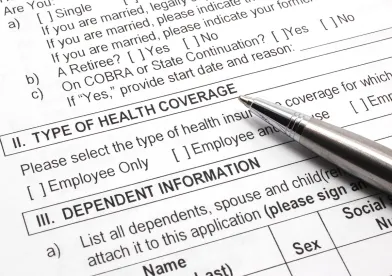On May 18, 2021, the IRS released Notice 2021-31, which provides implementation guidance on the COBRA premium subsidy available under the American Rescue Plan Act of 2021 (ARP). As discussed in our prior blog posts, ARP includes a 100% COBRA premium subsidy for qualifying individuals during periods of COBRA continuation coverage from April 1, 2021 through September 30, 2021.
The guidance in Notice 2021-31 includes helpful information for employers and plan sponsors administering the COBRA premium subsidy and claiming the related tax credit. At the same time, however, the Notice introduces new questions regarding the subsidy that may require future Treasury and IRS input. Read below for more details about the guidance, and stay tuned for additional blog posts that dive into the issues summarized below.
Eligibility for COBRA Premium Assistance and Self-Certification
To receive COBRA premium assistance, an individual must be an “Assistance Eligible Individual,” which is defined in Notice 2021-31 as any individual who: (1) is a qualified beneficiary as the result of the covered employee’s reduction of hours or involuntary termination of employment; (2) is eligible for COBRA coverage for some or all of the COBRA premium subsidy period (April 1, 2021 through September 30, 2021); and (3) elects COBRA.
Notice 2021-31 confirms that an employer or other plan sponsor may require individuals to self-certify or attest that they meet the eligibility criteria to receive the COBRA premium subsidy and are not eligible for other disqualifying health coverage or Medicare. An employer or other plan sponsor may rely on the individual’s attestation for the purpose of substantiating eligibility for the tax credit unless the entity has “actual” knowledge that the attestation is incorrect.
In a somewhat surprising twist, Notice 2021-31 states that individuals whose initial 18-month COBRA period was extended due to a disability determination, second qualifying event, or an extension under State mini-COBRA, are eligible for the COBRA premium subsidy during their extended COBRA period, provided that the original qualifying event was a covered employee’s reduction in hours or involuntary termination of employment and the individual elected COBRA coverage and remained on such coverage during the extended period. More context on this rule—including what notices (if any) these individuals are required to receive—would be helpful for implementation purposes.
Reduction in Hours/Involuntary Termination of Employment
To qualify as an Assistance Eligible Individual, the qualified beneficiary must have lost coverage as a result of the covered employee’s “reduction in hours” or “involuntary termination of employment.” Notice 2021-31 provides guidance on the definition of “involuntary” for this purpose, and includes pandemic-specific examples relating to terminations resulting from workplace safety issues and inability to obtain childcare. The Notice also addresses issues relating to furloughs and work stoppages, and includes examples of qualifying terminations in the context of window arrangements and retirement.
Coverage that Qualifies for COBRA Premium Assistance
COBRA premium assistance is available for COBRA coverage that is otherwise available under a group health plan subject to ERISA, the Internal Revenue Code, or the PHSA (except for health FSAs), as well as coverage pursuant to a state law that requires continuation coverage comparable to federal COBRA coverage. Notice 2021-31 addresses several questions regarding the “type” of COBRA coverage that qualifies for COBRA premium assistance. The Notice confirms that COBRA premium assistance is available for coverage under a vision-only or dental-only plan, and provides details about qualifying retiree coverage and coverage under a health reimbursement account (HRA). The Notice also supplies guidance on what types of state continuation coverage qualify for COBRA premium assistance.
Extended COBRA Election Period
One key feature of the COBRA premium assistance available under ARP is the “extended election period”—a special election window for individuals who previously declined or discontinued COBRA coverage, but who would be Assistance Eligible Individuals if enrolled in COBRA during the COBRA premium subsidy period (April 1, 2021 through September 30, 2021). For the most part, the Notice is silent on “who” is eligible for the extended election period—a question on which stakeholders were hoping for more detail from the IRS. However, the Notice answers a “grab bag” of other questions on the extended election period. One point addressed in the Notice is that individuals who were offered COBRA coverage for both comprehensive medical and also dental and vision coverage but previously elected COBRA coverage only with respect to dental or vision coverage must also be offered the extended election period with respect to the comprehensive medical coverage. The Notice also confirms that the extended election period is not available if the continuation coverage is provided solely under a state program.
Implications of Special Emergency Disaster Relief
In response to the COVID-19 pandemic, the DOL, HHS, and IRS provided a special tolling period for certain deadlines under employee benefit plans, including the deadline for qualified beneficiaries to elect COBRA coverage and make COBRA premium payments. Notice 2021-31 confirms that this special tolling relief does not apply to the 60-day deadline for an individual to elect COBRA continuation coverage with premium assistance or to the plan administrator’s obligation to furnish extended election period notices by May 31, 2021. Stay tuned for a future blog post covering additional details about the interaction between the special tolling relief and COBRA premium assistance.
Calculation of COBRA Premium Assistance Credit
COBRA premium assistance is implemented by means of a tax credit, whereby the person to whom COBRA premiums would otherwise be payable may claim a tax credit in the amount of the premium. In general, the credit for the applicable quarter is equal to the amount of the COBRA premiums that are not paid by Assistance Eligible Individuals, including any applicable administrative fee. Notice 2021-31 provides guidance on the calculation of this tax credit, including details on how to calculate the credit if the employer subsidizes COBRA premiums for individuals who are not eligible for COBRA premium assistance and how to allocate the credit if COBRA coverage also is provided to individuals who are not eligible for the subsidy.
Claiming the COBRA Premium Assistance Credit
The COBRA premium assistance tax credit is available to the premium payee for the COBRA continuation coverage. Notice 2021-31 includes details on “who” qualifies as a premium payee for purposes of claiming the credit and “when” the premium payee can first claim the credit, as well as details for premium payees wishing to request an advance of the anticipated tax credit. The Notice also provides directions on how to claim the tax credit for premium payees without any employment tax liability (such as a multiemployer plan with no employees), as well as premium payees that use a third-party payer to report and pay employment taxes to the IRS.





 />i
/>i

